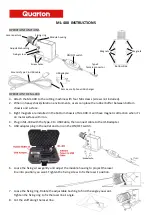
<Appendix 3. Arithmetic (Ar) Block>
256
IM 01E21A02-03EN
A3.2 Input Section
There are five inputs: IN and IN_LO main inputs and IN_1, IN_2, and IN_3 auxiliary inputs.
IN and IN_LO are intended to connect devices with different measurement ranges and allow
the use of switching a measurement range by selecting the measuring device. However,
because there are slight differences between IN and IN_LO values even when the same item
is measured, instantaneous switching causes abrupt changes in the output. To prevent this
phenomenon, the Arithmetic block uses a function known as range extension to compensate
the IN and IN_LO values between RANGE_HI and RANGE_LO. This enables the input to be
switched smoothly. The result of the range extension function is substituted into PV to be used for
calculations.
A3.2.1 Main Inputs
The range extension function determines the PV value in the following order:
1. If IN ≥ RANGE_HI =>
PV = IN
2. If IN ≤ RANGE_LO =>
PV = IN_LO
3. If RANGE_HI > IN > RANGE_LO => PV = g x IN + (1 - g) x IN_LO
g = (IN - RANGE_LO) / (RANGE_HI - RANGE_LO)
RANGE_HI and RANGE_LO are threshold values for switching two main inputs bumplessly.
FA0302.EPS
RANGE_LO
PV = IN_LO
PV=g 3 IN+(1-g) 3 IN_LO
PV =IN
RANGE_HI
IN
Formula based on
(1) and (2)
(2): Range for IN
(1): Range for IN_LO
PV is a parameter with status information, and PV status is determined with the value of “g”.
If “g” < 0.5 => The status of IN_LO is used
If “g” ≥ 0.5 => The status of IN is used
The determination of the status is made with a hysteresis of 10% provided for 0.5.
If RANGE_LO > RANGE_HI, the statuses of PV and OUT are “Bad.Configuration Error”. Then,
“Configuration Error”. is output to BLOCK_ERR.
If the main input is one input, the input is reflected as is, RANGE_HI and RANGE_LO are not
taken into account.
















































